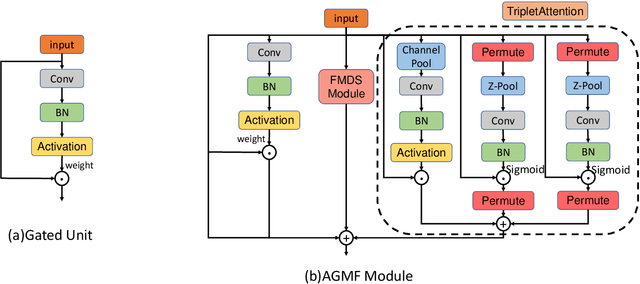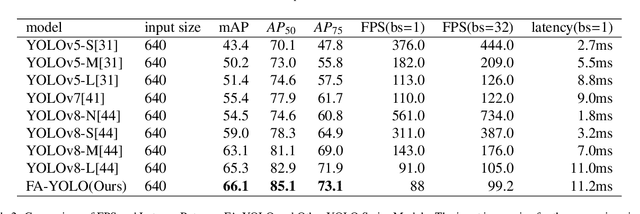Qingbin Tian
FMRFT: Fusion Mamba and DETR for Query Time Sequence Intersection Fish Tracking
Sep 02, 2024Abstract:Growth, abnormal behavior, and diseases of fish can be early detected by monitoring fish tracking through the method of image processing, which is of great significance for factory aquaculture. However, underwater reflections and some reasons with fish, such as the high similarity , rapid swimming caused by stimuli and multi-object occlusion bring challenges to multi-target tracking of fish. To address these challenges, this paper establishes a complex multi-scene sturgeon tracking dataset and proposes a real-time end-to-end fish tracking model, FMRFT. In this model, the Mamba In Mamba (MIM) architecture with low memory consumption is introduced into the tracking algorithm to realize multi-frame video timing memory and fast feature extraction, which improves the efficiency of correlation analysis for contiguous frames in multi-fish video. Additionally, the superior feature interaction and a priori frame processing capabilities of RT-DETR are leveraged to provide an effective tracking algorithm. By incorporating the QTSI query interaction processing module, the model effectively handles occluded objects and redundant tracking frames, resulting in more accurate and stable fish tracking. Trained and tested on the dataset, the model achieves an IDF1 score of 90.3% and a MOTA accuracy of 94.3%. Experimental results demonstrate that the proposed FMRFT model effectively addresses the challenges of high similarity and mutual occlusion in fish populations, enabling accurate tracking in factory farming environments.
A method for detecting dead fish on large water surfaces based on improved YOLOv10
Aug 31, 2024



Abstract:Dead fish frequently appear on the water surface due to various factors. If not promptly detected and removed, these dead fish can cause significant issues such as water quality deterioration, ecosystem damage, and disease transmission. Consequently, it is imperative to develop rapid and effective detection methods to mitigate these challenges. Conventional methods for detecting dead fish are often constrained by manpower and time limitations, struggling to effectively manage the intricacies of aquatic environments. This paper proposes an end-to-end detection model built upon an enhanced YOLOv10 framework, designed specifically to swiftly and precisely detect deceased fish across extensive water surfaces.Key enhancements include: (1) Replacing YOLOv10's backbone network with FasterNet to reduce model complexity while maintaining high detection accuracy; (2) Improving feature fusion in the Neck section through enhanced connectivity methods and replacing the original C2f module with CSPStage modules; (3) Adding a compact target detection head to enhance the detection performance of smaller objects. Experimental results demonstrate significant improvements in P(precision), R(recall), and AP(average precision) compared to the baseline model YOLOv10n. Furthermore, our model outperforms other models in the YOLO series by significantly reducing model size and parameter count, while sustaining high inference speed and achieving optimal AP performance. The model facilitates rapid and accurate detection of dead fish in large-scale aquaculture systems. Finally, through ablation experiments, we systematically analyze and assess the contribution of each model component to the overall system performance.
FA-YOLO: Research On Efficient Feature Selection YOLO Improved Algorithm Based On FMDS and AGMF Modules
Aug 29, 2024



Abstract:Over the past few years, the YOLO series of models has emerged as one of the dominant methodologies in the realm of object detection. Many studies have advanced these baseline models by modifying their architectures, enhancing data quality, and developing new loss functions. However, current models still exhibit deficiencies in processing feature maps, such as overlooking the fusion of cross-scale features and a static fusion approach that lacks the capability for dynamic feature adjustment. To address these issues, this paper introduces an efficient Fine-grained Multi-scale Dynamic Selection Module (FMDS Module), which applies a more effective dynamic feature selection and fusion method on fine-grained multi-scale feature maps, significantly enhancing the detection accuracy of small, medium, and large-sized targets in complex environments. Furthermore, this paper proposes an Adaptive Gated Multi-branch Focus Fusion Module (AGMF Module), which utilizes multiple parallel branches to perform complementary fusion of various features captured by the gated unit branch, FMDS Module branch, and TripletAttention branch. This approach further enhances the comprehensiveness, diversity, and integrity of feature fusion. This paper has integrated the FMDS Module, AGMF Module, into Yolov9 to develop a novel object detection model named FA-YOLO. Extensive experimental results show that under identical experimental conditions, FA-YOLO achieves an outstanding 66.1% mean Average Precision (mAP) on the PASCAL VOC 2007 dataset, representing 1.0% improvement over YOLOv9's 65.1%. Additionally, the detection accuracies of FA-YOLO for small, medium, and large targets are 44.1%, 54.6%, and 70.8%, respectively, showing improvements of 2.0%, 3.1%, and 0.9% compared to YOLOv9's 42.1%, 51.5%, and 69.9%.
Neural Radiance Field-based Visual Rendering: A Comprehensive Review
Mar 31, 2024



Abstract:In recent years, Neural Radiance Fields (NeRF) has made remarkable progress in the field of computer vision and graphics, providing strong technical support for solving key tasks including 3D scene understanding, new perspective synthesis, human body reconstruction, robotics, and so on, the attention of academics to this research result is growing. As a revolutionary neural implicit field representation, NeRF has caused a continuous research boom in the academic community. Therefore, the purpose of this review is to provide an in-depth analysis of the research literature on NeRF within the past two years, to provide a comprehensive academic perspective for budding researchers. In this paper, the core architecture of NeRF is first elaborated in detail, followed by a discussion of various improvement strategies for NeRF, and case studies of NeRF in diverse application scenarios, demonstrating its practical utility in different domains. In terms of datasets and evaluation metrics, This paper details the key resources needed for NeRF model training. Finally, this paper provides a prospective discussion on the future development trends and potential challenges of NeRF, aiming to provide research inspiration for researchers in the field and to promote the further development of related technologies.
 Add to Chrome
Add to Chrome Add to Firefox
Add to Firefox Add to Edge
Add to Edge